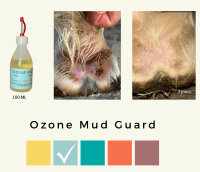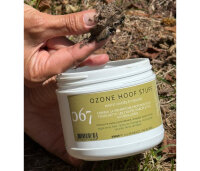The bulbs are a sensitive area on the horses hooves and is often exposed to dirt and moisture. This exposed area is sometimes neglected in daily care. Even tiny cracks can become real entry points for serious infections that can jeopardise the entire health of the hoof. OZONE BULB GUARD is the only product on the market specifically designed to protect and treat hoof pads.
Ozone Bulb Guard treats existing infections while forming a protective barrier against external pathogens, reducing the risk of new infections developing. Regular use of this product strengthens the health of the hoof pads and thus has a preventive effect against various hoof infections.
Why Ozone Bulb Guard?
- Comprehensive care: Protect, repair and maintain the health of the sensitive area of the hoof bulbs with a natural and effective product
- Easy to apply: The thick texture makes it easy to apply and ensures that the product adheres perfectly to the treated area and has a long-lasting effect
Some facts about "ozone" as an alternative remedy
Ozone (O3) is a molecule consisting of 3 oxygen atoms. "Ozone" comes from the ancient Greek ὄζειν ozein "to smell", ὄζον ozon: literally "that which smells" - we know the characteristic smell of ozone from the characteristic odour after a summer thunderstorm.
Ozone is the high-energy form of oxygen (O2). While oxygen consists of only two oxygen atoms, the ozone molecule has a third atom. As a result, it is extremely willing to bond and reacts with numerous substances. O3 triggers oxidation, i.e. the combination of oxygen atoms with other molecules. Because of its reactivity and instability, O3 can inactivate micro-organisms, stimulate oxygen metabolism in tissues, oxidise certain pro-inflammatory mediators and release growth factors in platelets. By binding to harmful substances, it neutralises them and breaks them down into harmless substances. Formaldehyde, for example, is broken down by O3 into water, carbon dioxide and oxygen.
Through a process called "ozonisation", ozone can be incorporated into the structure of the oil. The reaction of a fatty acid with ozone produces new, reactive compounds such as ozonides, peroxides and aldehydes. When used externally by application, these compounds can penetrate into deeper layers of the skin and release the oxygen (O2) they contain directly to the damaged tissue over several hours. In this way, the tissue is supplied with more oxygen and germs and viruses can be partially reduced.
The ozonisation of oils also produces the acids caproic and pelargonic, whose antimicrobial (germicidal) and fungicidal effects have long been known.
The increased oxygen supply to the tissue and improved blood flow in the epidermis stimulate cell regeneration and wound healing. Scientific study on the use of ozonated oil for cell regeneration and wound healing.
Ozone oil has been proven to be effective against viruses, bacteria and parasites. The successful treatment of fungal infections with ozonised oil was investigated and confirmed in this scientific article.
Ozonised oil can be used internally and externally for many different applications. Only the absorption of the gas via the respiratory tract is harmful; this risk is not present with ozonised oil because the gas is bound in the oil.

 German
German French
French



